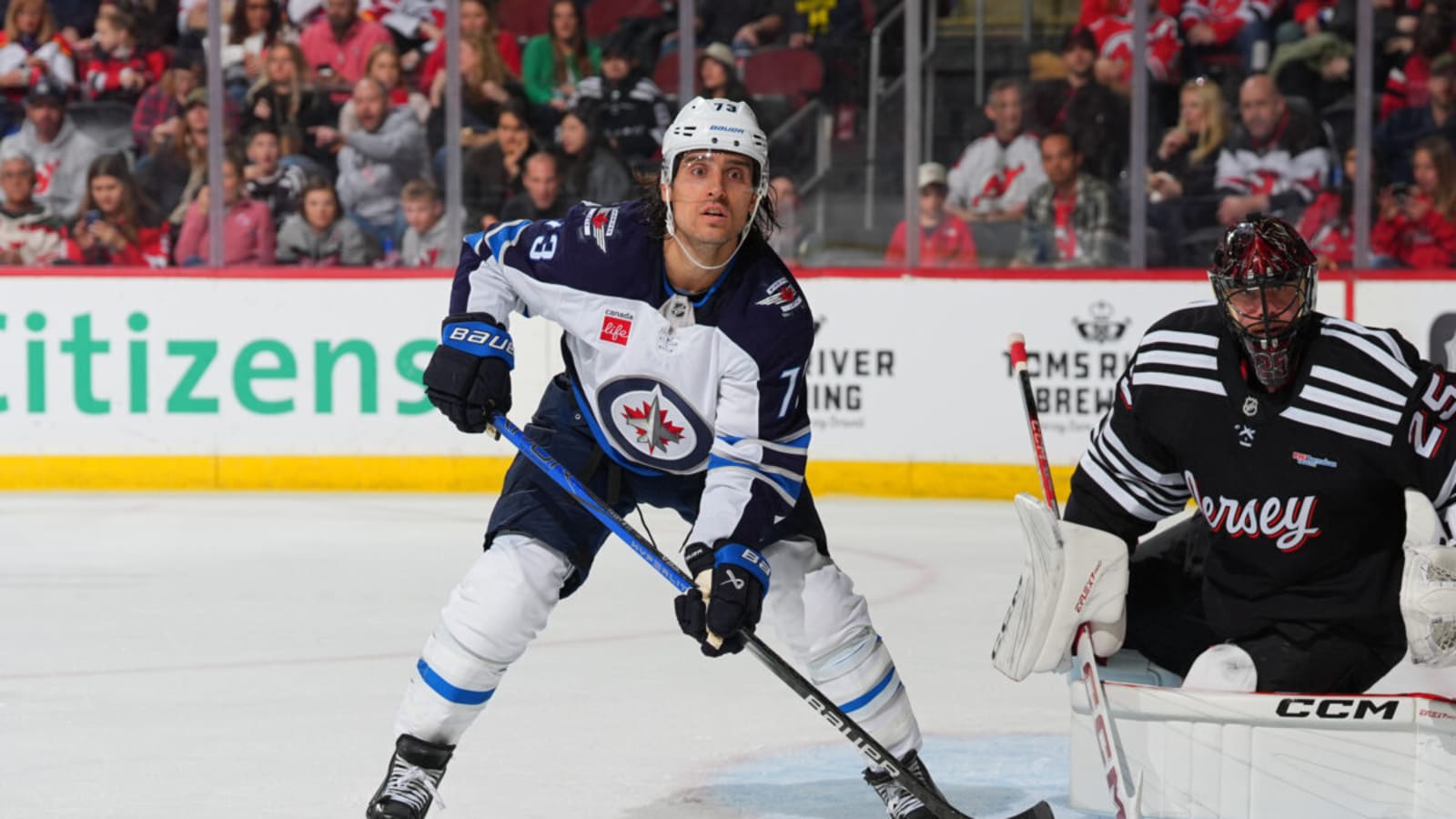
As quickly as it arrived, the NHL Trade Deadline passed, and the Winnipeg Jets stayed fairly quiet as the clock ran out. In what was one of the most shocking deadlines of the past several years, star players found new homes and helped some of the NHL’s cup contenders solidify already impressive rosters.
Most deals were made to address specific needs, which is what most expected the Jets to do on deadline day, as they were armed with assets and cap space to make some noise. After the dust settled, that just didn’t happen. Two depth acquisitions were all that came over the wire for the Jets, and that has many wondering if more could have been done.
No Upgrade at Center, Tanev Added for Depth
Perhaps the most talked about positional need for the Jets, and what has largely been the talking point for the last decade, is their lack of a true second-line center. We all know their history in trading to fill those holes, acquiring the likes of Paul Stastny, Kevin Hayes, and Sean Monahan to try and fill that gap.
This year, the conversation was no different, as the Jets were looking to upgrade that spot. Vladislav Namestnikov, who has been such a valuable piece to this team, has been the second-line center nearly all season. While he’s been able to keep afloat, that’s just not what his game is built for.
It’s not a slight to Namestnikov, but his defense-first game is far more appreciated in the bottom six than the top six, and at times, it’s been apparent. Finding a true second-line center to play between Nikolaj Ehlers and Cole Perfetti would have made for a matchup nightmare for opponents in the playoffs.
By this point, most know that the Jets’ target for that spot was Brock Nelson, the veteran scoring center who had played for the New York Islanders his whole career until the night before the deadline. It was then that the Jets found out that they had missed on Nelson, who was traded to their divisional foe, the Colorado Avalanche.
Now, it was clear Nelson was the clear-cut, number one center target on everyone’s boards, and for good reason. That said, there were still a few options out there that could have been a “Plan B” for the Jets. That said, it came out early on deadline day in a report from Elliotte Friedman that the Jets’ “Plan B” could be Brandon Tanev. That report became a reality, as the Jets acquired Tanev for a second-round pick.
Tanev, 33, is a speedy depth winger who began his career in Winnipeg before making stops with the Pittsburgh Penguins and Seattle Kraken. In the years away from the Jets, his game has dipped significantly, and now he only really profiles as that energetic fourth-line speedy penalty killer or 13th-forward type. The Jets already have those types of players who can skate really quickly but don’t necessarily do much outside of that speed.
Given the actual need of the forward group, Tanev’s addition doesn’t really make sense in terms of addressing any concerns of that group. If he was a supplemental move in addition to a big splash to address the center depth, it would be easier to make sense of, but paying a second-round pick for a 33-year-old Tanev seems to be missing the mark a bit.
Schenn Adds Depth but Doesn’t Fit the Jets’ Needs
In addition to the Tanev add, the Jets also added some depth on the back end. Luke Schenn, a 35-year-old journeyman defenseman is joining the Jets, who will be the ninth team he has played for in his career. Known as more of a tough, stay-at-home defender for most of his career, he has slowed down in recent years after winning a pair of Stanley Cups with the Tampa Bay Lightning.
It’s not so much the fact that the Jets added Schenn because in a depth role with specific types of partners, he can likely still be effective in those sheltered minutes. The problem that appears to be brewing is that as a right-handed defender who plays on the right side, he’ll be replacing Colin Miller on that third pairing. Miller has been solid in his minutes this season, and taking him out doesn’t really solve any problems.

Perhaps the most glaring issue isn’t the replacement of Miller, but the stylistic fit next to Logan Stanley on that third pairing. Now, there is a remote possibility that the Jets may use Schenn as someone who can bear the load of being that “size factor” on the pairing and give Stanley a few nights off, but that doesn’t seem to align with what we’ve seen this season.
What appears to be happening, then, is Schenn being paired with Stanley on that pairing, making that duo an immediate target for opposing teams. The biggest issue in last season’s first-round disaster was how easily the Jets were outskated by a much faster Avalanche team. By potentially pairing Stanley and Schenn together, they will make up one of the slowest pairings in the entire NHL.
Ideally, the Jets needed to add someone with size but who could also skate in transition. I had mentioned in an article earlier this week that Rasmus Ristolainen made sense, but unless prices went down, it appeared that scared teams off.
I understand the sentiment of acquiring someone to increase toughness before the playoffs, but bringing in another big, slow defender isn’t going to make the Jets any harder to play against. It’s only going to make it easier for a team with speed to find a hole to exploit.
With how well Miller had played to this point in the season, it would have made more sense to just stand pat in that situation if an impact, big, puck mover wasn’t available. Instead, the acquisition of Schenn could be a detriment to that defensive core down the stretch.
The Central Gets Better
Perhaps this would be less of a conversation if the rest of the division had a quiet week and the status quo remained. That just didn’t happen. The pair of Schenn and Tanev provide value in their depth and experience, but is that enough given the action that happened around the division?
The Avalanche solidified their forward group by adding both Nelson and Charlie Coyle, adding to an already dangerous team. Possibly forgotten given the early movement, but Martin Necas, who was acquired for Mikko Rantanen has been outstanding for the Avalanche since coming over from the Carolina Hurricanes.
The Dallas Stars also made a huge splash, acquiring Rantanen from the Hurricanes and subsequently signing him to an eight-year extension worth $12 million per season. He’s joining a team that is already second in the Western Conference who are eventually going to be welcoming back Tyler Seguin and Miro Heiskanen to their lineup after extended injury absences.
The Central Division is going to be an absolute dogfight down the stretch, and that will almost certainly carry into the playoffs. The Jets essentially need to do just one thing to make their life a tad easier, and that’s finish first. Finish first, and it’s more than likely that the Stars and Avalanche will be forced to beat up on each other in the first round.
To make it clear, as hard as I’ve been on these two depth deals, I’m not doubting that the Jets are still having an amazing season. They’ve proven time and time again that they’re the class of the league, and it’s going to take a lot to change that. It felt like the team was saying just that when after the deadline passed, they went and demolished the New Jersey Devils 6-1. If there was a definition of a “statement game” in the dictionary, maybe that’s what you’d see.
I’m hesitant to call the deadline inconsequential for the Jets because I think it’s just one of those moments where the belief in the team is so strong that it was more of a “this is our year” statement from management. That said, it wouldn’t have negated that sentiment if they went out and made a splash to solidify themselves as that true cup contender, rewarding the team for positioning themselves so well.
The Jets had their next three first-round picks, over $12 million in deadline cap space, and a wealth of prospects that aren’t “untouchable” by any means. With all of that at their disposal, is there a chance that leaving the deadline with $6 million and all of your picks still intact is a mistake? We’ll only know the answer to that once this season ends.
It’s About Results
We’re just under a year removed from watching one of the best seasons in franchise history end abruptly, and two years removed from another quick exit from the postseason. It’s not some outlandish idea to find that difference maker in positions of need to try and avoid the same fate.
As good as this team has been in 2024-25, external perspectives still view the Jets as a team that fizzles out in the playoffs. Is this the group, almost entirely unchanged from the start of the season, who will buck that trend? Or will there be a cloud of disappointment that has people asking what else could have been done?
Luckily, I can’t see the future, so for all we know the Jets prove the doubters wrong and make a run. It wouldn’t surprise me at all, given the fact they’ve spent most of their season in first place and are in contention for the President’s Trophy for the first time since 2017-18.
There’s a belief in the group, clearly, but is this team different from the last two seasons? One thing is for certain, this trade season didn’t sway them in one direction or the other. Whether that’s a good thing or not will be proven once the stakes get higher.
More must-reads:
- Penguins' latest collapse reached historic level of incompetence
- Minnesota Wild's blockbuster trade for Quinn Hughes comes at perfect time
- The '2025-26 bowl game host cities' quiz
Breaking News
Trending News
Customize Your Newsletter
 +
+
Get the latest news and rumors, customized to your favorite sports and teams. Emailed daily. Always free!








